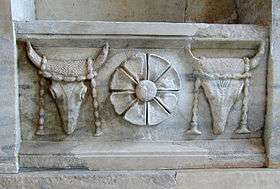Bucranium

Bucranium (plural bucrania; Latin, from Greek βουκράνιον, referring to the skull of an ox) was a common form of carved decoration in Classical architecture used to fill the metopes between the triglyphs of the frieze of Doric temples. A bas-relief or painted decor consisting of a series of bucrania draped or decorated with garlands of fruit or flowers was a Roman motif drawn from marble altars, which have survived in some number; the motif was also later used on Renaissance, Baroque and Neoclassical buildings. The name is generally considered to be a reference to the practice of garlanding sacrificial oxen, the heads of which were displayed on the walls of the temples, a practice with a long history reaching back to the sophisticated Neolithic site of Çatalhöyük in eastern Anatolia, where cattle skulls were overlaid with white plaster.
A rich and festive Doric order was employed for the Basilica Aemilia on the Roman Forum; enough of it was standing for Giuliano da Sangallo to make a drawing, c 1520, reconstructing the facade (Codex Vaticano Barberiniano Latino 4424); the alternation of the shallow libation dishes called paterae with bucrania in the metopes reinforce the solemn sacrificial theme. With time, during the sixteenth century, the connection with sacrifices faded and bucrania became part of a decorative vocabulary that evoked "Roman-ness".
In serious, post-antique contexts that follow the classical conventions, the presence of bucrania signifies that the Doric order is the organizing principle, but the Romans were not always so strict. In a first-century fresco from Boscoreale, protected by the eruption of Mount Vesuvius and now at the Metropolitan Museum of Art, bucrania and cistae mysticae hang on ribbons from pegs that support garlands, evoking joyous fasti. The Temple of Vesta, Tivoli, in the Corinthian order, also has bucrania in its frieze, or at least motifs interpreted by Andrea Palladio as conventional skull bucrania.[1] They are in fact fleshed ox heads with eyes. Similarly, the Ionic Temple of Portunus in Rome has conventional bucrania in its frieze.[2]
Garlanded bucrania provide a repetitive motif in the plasterwork of the fine 18th century Staircase Hall of The Vyne (Hampshire), inside the Pantheon at Stourhead (Wiltshire) and at Lacock Abbey (Wiltshire).[3]
See also
Notes
- ↑ Loth, Calder, "CLASSICAL COMMENTS: CAN WE TRUST PALLADIO? Antoine Desgodetz Details Palladio’s Inaccuracies", Institute of Classical Architecture & Art, The Classicist Blog
- ↑ Loth, Calder, "CLASSICAL COMMENTS: Bucrania", Institute of Classical Architecture & Art, The Classicist Blog
- ↑ See Loth "Bucrania" for many more examples
References
- Francis Brenders, "The Basilica Aemilia on the Forum Romanum at Rome
- Garlanded bucrania on the Ara Pacis
- Sir William Chambers, A Treatise on the Decorative Part of Civil Architecture, 1791 : Doric order with bucrania between triglyphs
- Garlanded bucrania on the Tomb of Cecelia Metella
- Sylloge Nummorum Gracorum: Rubi: obols with garlanded bucrania on reverse
Further reading
- George Hersey, 1988. The Lost Meaning of Classical Architecture: Speculations on Ornament from Vitruvius to Venturi, (MIT Press) Chapter 2: "Architecture and Sacrifice"
| Wikimedia Commons has media related to :Category:Bucrania. |